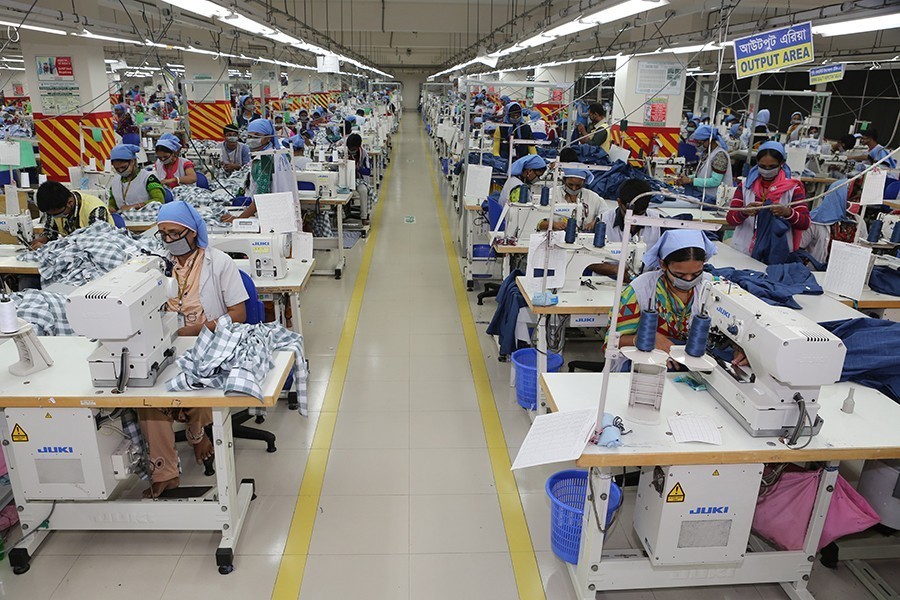Local garment manufacturers need to focus on Asian countries as the net export values in the first quarter of the current fiscal declined considerably due to higher prices of raw materials, Bangladesh Bank said in its latest quarterly review.
The central bank has also suggested that apparel makers should diversify products with high-valued man-made fibres (MMF) and global technical textile to fetch more export receipts.
As the economic turbulent situation continues to persist in major export-destination countries, Bangladesh should target promising Asian economies like Japan, India, China, South Korea and the Middle East, the BB said in its quarterly review report on RMG sector.
The net export earnings from readymade garment (RMG) sector in the first quarter of FY '23 dropped to $5.29 billion, registering a 12.49 per cent decline from $6.04 billion in the previous quarter (April to June of 2022).
The net exports were determined by subtracting RMG raw-material import value from the total RMG export value.
During the first quarter of FY '23, RMG exports stood at $10.27 billion while import of raw materials during the period was $4.98 billion or 48.51 per cent of total RMG export earnings, according to the review report.
The central bank considered the main head value of the components (raw cotton, synthetic/viscose fibre, synthetic/mixed yarn, cotton yarn, textile fabrics, and accessories for garments) instead of only raw materials brought through back to back L/Cs, it said.
The net RMG exports in the first quarter of FY '23, however, increased by 9.31 per cent from $4.84 billion in the same period of FY '22.
According to industry insiders, Bangladesh is largely dependent on imported raw materials, such as cotton, petro-chemicals and chemicals, despite being the second-largest RMG exporter.
And net export earnings declined because the prices of raw materials and freight costs have increased significantly due to the Russia-Ukraine war, they said.
They also pointed out that the value addition in the knitwear sub-sector is higher than that of woven segment, as knit exporters source about 80 per cent of their required raw materials from the local market while woven exporters meet their larger share through imported fabrics.
Asked, Bangladesh Garment Manufacturers and Exporters Association (BGMEA) President Faruque Hassan said prices of raw materials have significantly gone up during the last two years mainly because of the pandemic, demand surge in the post-lockdown period, high cost of freights and the Russia-Ukraine war.
Though unit prices of apparel items have increased, the net export earnings declined mainly because of high raw materials prices and freight costs, resulting from Russia-Ukraine war, he noted.
Considering the turmoil situation in the global economy, he said, Bangladesh is still doing better, compared to other competitors.
"And we are now focusing more on potential Asian markets such as India, Japan and Korea," he said, adding that entrepreneurs are investing in man-made fibre production.
However, policy supports are needed to increase exports of non-cotton and MMF items, as they need a huge investment, he said.
The BB review report also showed that the United States, Germany, the United Kingdom, Spain, France, the Netherlands, Italy, Canada, and Belgium are the top destinations for Bangladesh's RMG exports.
The country fetched US$7.42 billion from these nine countries, which accounted for 72.25 per cent of the total RMG exports in the first quarter of FY '23.
Data analysis showed that value addition fell to 54.50 per cent in fiscal year of 2021-22, which was 59.13 per cent in 2020-21.
According to the central bank data, local RMG items' value addition remained almost static at 60 per cent from FY 2013-14 to FY 2017-18.
In FY '22, Bangladesh fetched US$42.61 billion from RMG exports, while it imported raw materials worth $19.43 billion. Thus, the country's net RMG exports stood at $23.22 billion in the last fiscal, showing a 54.50 per cent value addition.
Still, the value addition remained lower than the pre-pandemic level -- 64.32 per cent in FY '19, the data show.


